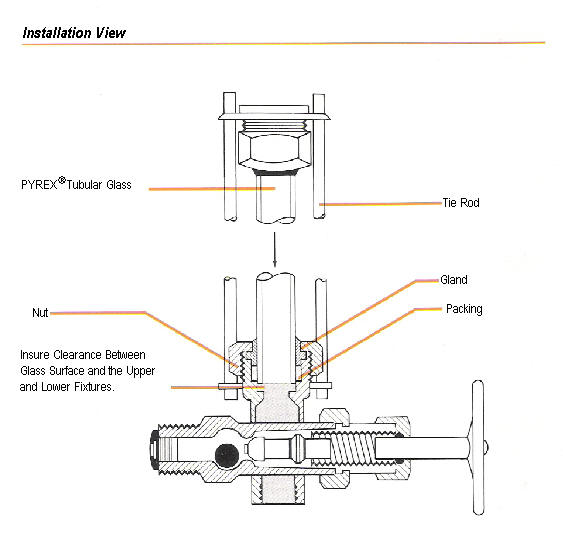|
|
INSTALLATION AND USAGE GUIDELINES |
|
|
|
|
USE AND CARE |
|
|
|
|
|
|
|
|
|
|
|
Maintenance |
|
|
|
|
|
|
|
|
|
|
|
|
|
|
Examine the gage glass regularly for any signs of clouding, scratching, |
|
erosion, or corrosion. In new processes, the glass should be inspected |
|
daily until the need for replacement becomes apparent. This will help |
|
establish the routine inspection and routine replacement cycles. |
|
|
|
|
|
|
|
|
|
|
Cleaning |
|
|
|
|
|
|
|
|
|
|
|
|
|
|
|
Keep gage glass clean using non-abrasive commercial glass cleaners. |
|
Where regular gleaners do not seem to work, use dilute acides shuch as |
|
Hydrochloric (muriatic) acid. Always observe safety rules when handing |
|
handling hazardous cleaning solutions. Never use wire brushes, metal |
|
scrapers, or harsh abrasives which could scratch the glass. |
|
|
|
|
|
|
|
|
|
|
Inspection |
|
|
|
|
|
|
|
|
|
|
|
|
|
|
Scratches, corrosion, chips, surface flaws, or nicks on the surface or |
|
edges weaken the gage glass. To examine for these, shine a very |
|
bright concentrated light ("Burton Lite" or powerful flashlight) at about |
|
45 degree angle. Anything which glistens and catches the fingernail |
|
or any star-shaped or crescent-shaped mark which glistens, is |
|
|
cause for replacement. Any gage glass which appears cloudy or |
|
|
roughened and will not respond to cleaning procedures, should be |
|
|
replaced. |
|
|
|
|
|
|
|
|
|
|
|
|
|
|
|
Storing |
|
|
|
|
|
|
|
|
|
|
|
|
|
|
|
Keep gage glasses in original packaging until ready to install. |
|
|
|
|
|
|
|
|
|
|
Handling |
|
|
|
|
|
|
|
|
|
|
|
|
|
|
|
Avoid bumping, chipping, or scratching gage glass. Any glass-to-glass |
|
contact can cause scratches and must be avoided. |
|
|
|
|
|
|
|
|
|
|
|
Installation |
|
|
|
|
|
|
|
|
|
|
|
|
|
|
Always follow tubular gage manufacturer's recommended procedures for |
|
glass replacement. |
|
|
|
|
|
|
|
|
|
|
|
|
|
|
Before installing a gage glass, remove all deposits from the seal contact |
|
surfaces of the gland nut and the gland (where used). Check sealing |
|
surfaces for cleanliness and smoothness. Once the gage glass has been |
|
removed from its mounting, regardless of the reason for its removal, |
|
discard the glass and replace with a new piece. |
|
|
|
|
|
|
|
|
|
|
|
Always use new paking, seals, and/or O-rings (if required) when |
|
|
replaceing a tubular gage glass. Used packing, seals, and O-rings will |
|
not properly support the gage glass or provide the proper pressure |
|
|
seal without stressing the glass. |
|
|
|
|
|
|
|
|
|
|
|
|
 |
|
1. Hold fittings rigidly to prevent misalignment, which can cause severe |
|
bending stresses in the glass, when packing nuts are tightened. |
|
|
|
|
|
|
|
|
|
|
2. Provide metal washers so nuts can be tightened without twisting |
|
packing or tube. |
|
|
|
|
|
|
|
|
|
|
|
|
|
|
3. Provide positive, but not excessive, clearance between glass, packing |
|
nuts, and bearing washers. |
|
|
|
|
|
|
|
|
|
|
|
|
|
4. Keep glass short enough to allow for expansion. |
|
|
|
|
|
|
|
|
|
|
|
5. Provide positive clearance between the ends of the gage glass and |
|
the metal fittings. Glass-to -metal contact will keep the gage galss from |
|
expanding and cause breakage. |
|
|
|
|
|
|
|
|
|
|
|
|
|
6. Tighten packing nuts enough to prevent leakage, but not so much |
|
that you hinder expansion and contraction. Follow gage manufacturer's |
|
recommendations. |
|
|
|
|
|
|
|
|
|
|
|
|
|
|
7. Generally, you can use cylindrical or conical runner packings for LOW |
|
and MEDIUM pressures. HIGHER pressure and HIGH temperature |
|
may require specialized packings. In all cases you should follow the |
|
recommendations of the gage manufacturer. |
|
|
|
|
|
|
|
|
|
|
|
|
|
|
|
|
|
|
|
|
|
|
|
|
|
|
|
Sources: Corning Incorporated brochure "Tubular Gage Glasses" |
|
|
Copyright 1991. |
|
|
|
|
|

